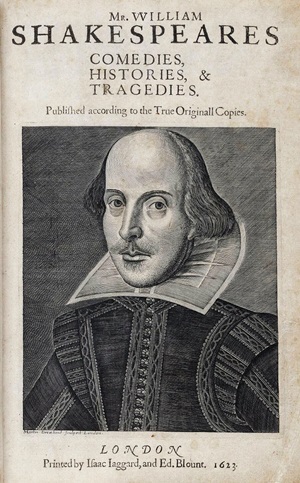Dec 23, 2025
Dec 23, 2025

Thirty-six plays with 1,233 characters speaking 8,44,421 words that spread over 900 pages are what we see between the covers of the First Folio of William Shakespeare printed by the father-and-son pair of William and Isaac Jaggard in 1623 at their shop near St Paul’s Cathedral, London.
First Folio owes its existence to two actors of The King’s Men: John Heminges and Henry Condell. These two compiled the Folio in the years that followed Shakespeare’s death. Though it is not clear as to what compelled them to undertake its compilation, one thing is certain: they held Shakespeare in high regard as their preface reveals: “His mind and hand went together… Reade him, therefore; and againe, and againe.”
 Over and above the texts of the plays, the folio contains certain interesting features. There is that iconic engraved portrait of Shakespeare by Martin Droeshout on the frontispiece. On the opposite page, there is a poem by Ben Jonson, Shakespeare’s friend and rival that asks readers to “look / Not on his picture, but his book”. For the first time, its table of contents shows how the plays were categorized by genre into Comedies, Histories and Tragedies. It also gives the list of the 26 actors who performed the plays in the Lord Chamberlain’s Men (later the King’s Men) theatre company.
Over and above the texts of the plays, the folio contains certain interesting features. There is that iconic engraved portrait of Shakespeare by Martin Droeshout on the frontispiece. On the opposite page, there is a poem by Ben Jonson, Shakespeare’s friend and rival that asks readers to “look / Not on his picture, but his book”. For the first time, its table of contents shows how the plays were categorized by genre into Comedies, Histories and Tragedies. It also gives the list of the 26 actors who performed the plays in the Lord Chamberlain’s Men (later the King’s Men) theatre company.
Shakespeare’s fans attach a great significance to the First Folio, for it presented his entire work—Mr William Shakespeare’s Comedies, Histories & Tragedies—in a single fancy keepsake volume. Here, we must bear in mind that it was published seven years after Shakespeare died by people who put time and effort into preserving his plays. Had the folio not been published, we might never have been able to read Macbeth, Julius Caesar, Twelfth Night, Antony and Cleopatra, The Comedy of Errors, As You Like It and The Tempest.
Without the effort of John Heminges and Henry Condell, “we wouldn’t even be talking about Shakespeare,” says Emma Smith, a Shakespearean scholar at the University of Oxford and the author of Shakespeare’s First Folio: Four Centuries of an Iconic Book. For, it had rescued the name of William Shakespeare and half of his plays from oblivion.
John Heminges and Henry Condell, and William and Isaac Jaggard have thus created a living memorial to Shakespeare. During the last 400 years, folio enabled generations of readers to listen to such wonderful characters—Cordelia, Desdemona, Volumnia, Hamlet, Macbeth, Romeo, Juliet, and hundreds of others—“speaking words that continue to move and inspire us”. Indeed, as Brian Cummings once said, today First Folio exists more as a fetish.
I am of course, not fortunate enough to turn the pages of First Folio and linger over lines like, “Oh, look upon me, Sir, / And hold your hands in benediction o’er me” from King Lear, but I do have a tremendous sense of reverence for the craftsmanship of its printers that even after 400 years there are as many as 228 copies of it still in existence out of the 750 copies said to have been printed originally. It is here in the folio that Shakespeare’s writing that emerged from the “unfathomable depths of his own oceanic mind” ultimately found its apotheosis by virtue of which it became a relic. And it is this relic that ultimately invented the Bard of the words within it. It is here in the folio that a reader finds the body and soul of Shakespeare. It is in it that we, the readers, encounter “forms more living than real men” exhibiting “the void between persons and the personal ideal”. It simply facilitates an easy understanding “of human nature”. Therefore, it’s hard not to see the folio as a sacred object.
As Tiffany Stern said, “Shakespeare isn’t famous as a person, he’s famous as a playwright. This folio anniversary is a celebration of what we actually admire Shakespeare for: a set of extraordinary plays. That’s why the Folio’s anniversary is so significant.”
As a playwright, Shakespeare touched on universal themes that transcend time and space. It is precisely for this reason that every generation, as Michael Witmore, director of the Folger Shakespeare Library in Washington, DC said, “makes Shakespeare their own, and every generation fights with him and loves him in their own way.”
The very performance of Shakespeare’s plays even after 400 years around the world wouldn’t have been possible if his friends had not gotten all his plays into First Folio after his death as a tribute to him. Suffice it to say that the First Folio remains as a symbol of literary preservation, nay the enduring power of Shakespeare’s plays and it is precisely for this reason that the First Folio deserves quatercentenary celebrations.
Image (c) istock.com
Image of the book cover courtesy Wikipedia
17-Dec-2023
More by : Gollamudi Radha Krishna Murty